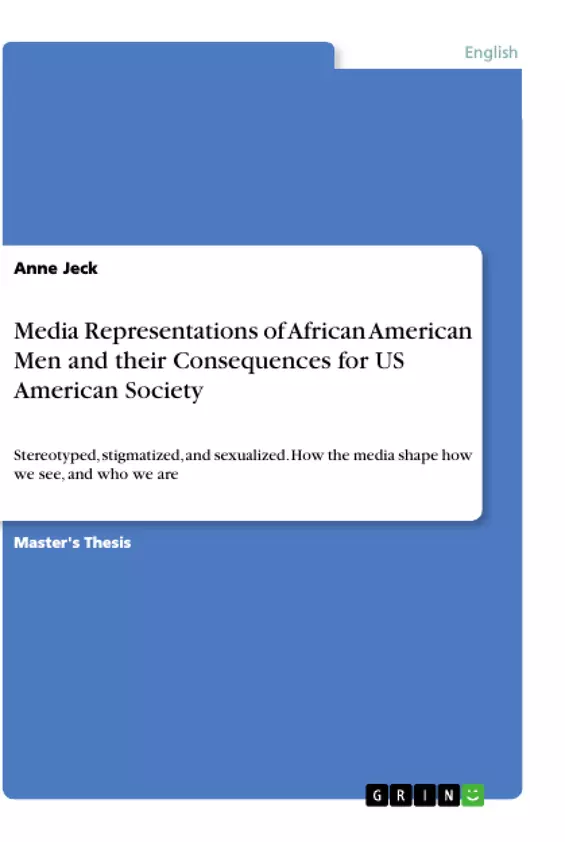The work at hand explores the depiction of African American men in the media and the consequences these specific ways of representation can have on their lives in US American society. Without narrowing the topic down to one particular media type, the present work will focus on both fictional and non-fictional forms of representation, including depictions in movies and TV series as well as displays in the news. By doing so, it shall untangle the tightly interwoven web of both fictional and non-fictional depictions that ensnares African American men in an opposing, yet overlapping way.
African American men’s position in contemporary US American society cannot be investigated under the assumption that their current situation results from a monocausal incident. Without confining the frame of investigation to one specific time period, the present work is oriented towards the most current research results, figures and developments available. As data availability depends on the topic of each subchapter individually, the general time frame cannot be narrowed down specifically. Also, as current events are triggered by various chains of causation, they can never be interpreted without being historized, culturalized and politicized. Therefore, they will be set in context, which might create the impression of partially exceeding the idea of topicality. However, the center of attention will stay on topical events that influence on-going developments in the US.
Inhaltsverzeichnis (Table of Contents)
- 1 INTRODUCTION
- 1.1 PROCEDURE
- 1.2 MAIN RESEARCH QUESTIONS AND HYPOTHESIS
- 2 THEORETICAL FRAMEWORK
- 2.1 TRIANGULAR APPROACH: INTOXICATED INTERSECTIONALITY FOR BLACK MEN
- 2.2 PRIME TIME: WHEN MEDIA PRIMING TURNS INTO MEDIA FRAMING
- 3 BLACKOUT: THE POLITICS OF VISIBILITY
- 4 BLACKLIST: LACK OF QUALITATIVE REPRESENTATION
- 4.1 BLACKFACE: COLORING CRIME
- 4.2 BLACKBOX: HYPER-SEXUALIZATION OF BLACK MEN
- 5 B(L)ACKLASH: RESHAPING MEDIA REPRESENTATIONS OF BLACK MEN
- 5.1 FROM CATEGORIZATION TO INDIVIDUATION
- 5.2 DE-CORPORALITY PROCESS
- 6 CONCLUSION AND DISCUSSION
Zielsetzung und Themenschwerpunkte (Objectives and Key Themes)
This research delves into the representation of African American men in US media, examining how these portrayals impact their perception and ultimately shape the fabric of US American society. The study seeks to uncover the intricate interplay between media representations and their consequences for African American men, highlighting the perpetuation of stereotypes, stigmatization, and hyper-sexualization within the media landscape.
- The influence of media portrayals on public perception of African American men
- The role of stereotypes, stigmatization, and hyper-sexualization in shaping social and political realities
- The intersectionality of race, gender, and class in the context of media representation
- The impact of media representations on the lived experiences of African American men
- The potential for challenging and reshaping media portrayals to promote more equitable representations
Zusammenfassung der Kapitel (Chapter Summaries)
- 1 INTRODUCTION: This chapter introduces the concept of collective racism and its pervasiveness in US society, exploring how media representations can shape and perpetuate societal beliefs and expectations. It further examines the role of the "American Dream" in fostering a belief in individual responsibility and the dismissal of systemic discrimination.
- 2 THEORETICAL FRAMEWORK: This chapter outlines the theoretical framework that underpins the research, specifically emphasizing the "Triangular Approach" and its intersectional lens for understanding the experiences of Black men. The chapter also explores the concept of "media priming" and its transformation into "media framing."
- 3 BLACKOUT: THE POLITICS OF VISIBILITY: This chapter delves into the politics of visibility, examining the underrepresentation of Black men in mainstream media and its consequences for their public image. It analyzes the impact of this lack of visibility on the broader understanding of African American experiences.
- 4 BLACKLIST: LACK OF QUALITATIVE REPRESENTATION: This chapter examines the lack of qualitative representation of Black men in media, highlighting the prevalence of negative stereotypes, including the criminalization of Black men and the hyper-sexualization of their bodies. It analyzes the historical and contemporary mechanisms that contribute to these distorted portrayals.
- 5 B(L)ACKLASH: RESHAPING MEDIA REPRESENTATIONS OF BLACK MEN: This chapter explores potential strategies for reshaping media representations of Black men, advocating for a shift from categorization to individuation and addressing the de-corporality process that often reduces them to one-dimensional depictions.
Schlüsselwörter (Keywords)
This research focuses on media representation, African American men, stereotypes, stigmatization, hyper-sexualization, intersectionality, race, gender, class, US American society, visibility, qualitative representation, media framing, and the impact of media on social and political realities.
- Citation du texte
- Anne Jeck (Auteur), 2017, Media Representations of African American Men and their Consequences for US American Society, Munich, GRIN Verlag, https://www.grin.com/document/975873



